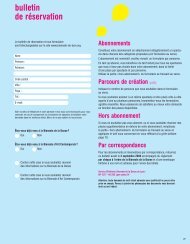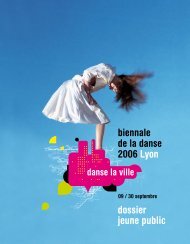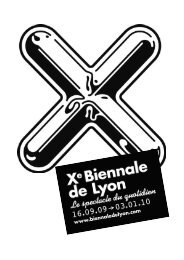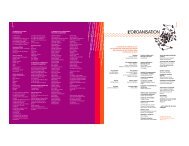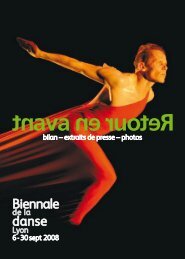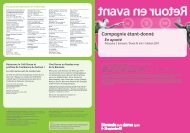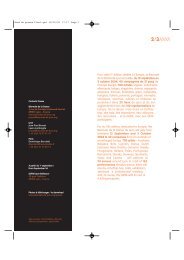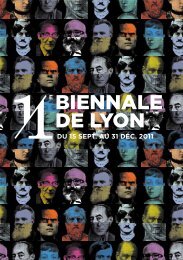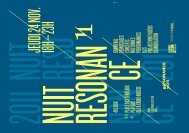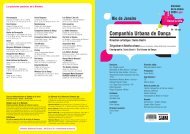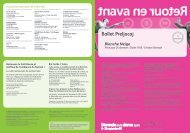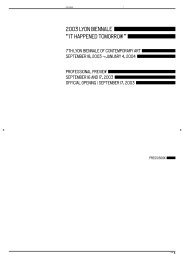Retour en Avant / Past Forward Biennale de la Danse Lyon - France
Retour en Avant / Past Forward Biennale de la Danse Lyon - France
Retour en Avant / Past Forward Biennale de la Danse Lyon - France
- No tags were found...
Create successful ePaper yourself
Turn your PDF publications into a flip-book with our unique Google optimized e-Paper software.
W<strong>en</strong> HuiW<strong>en</strong> Hui began dancing as a child.Aged 13, she started to studytraditional dance at the YunnanConservatory, before <strong>en</strong>tering thechoreography <strong>de</strong>partm<strong>en</strong>t of theBeijing Dance Aca<strong>de</strong>my. After graduating,she refused to perform onthe state circuit, preferring instead tocreate her own forms. She left to continueher contemporary-dance trainingin the United States and Europe, beforereturning to Beijing, where she foun<strong>de</strong>d herown company in 1994.The Living Dance Studio is one of the up-and-comingin<strong>de</strong>p<strong>en</strong>d<strong>en</strong>t companies on China’s artisticand cultural sc<strong>en</strong>e. It receives no state funding,and has ma<strong>de</strong> a huge contribution to <strong>de</strong>velopingnew forms of artistic expression. The company<strong>de</strong>fines itself as a collective of artists from differ<strong>en</strong>tbackgrounds. It aims to convey an image ofcontemporary China using multimedia, danceand theatre. “To me, dance is an expression ofid<strong>en</strong>tity, an interpretation of one’s own life,”says the choreographer. Her company’s mostfamous work is Report on Giving Birth (1999),which surveys the everyday life of Chinesewom<strong>en</strong>, their re<strong>la</strong>tionships with m<strong>en</strong> and theirp<strong>la</strong>ce in society, and in particu<strong>la</strong>r explores theirexperi<strong>en</strong>ce of motherhood.Memory / premiering at theBi<strong>en</strong>naleMy memories are re<strong>la</strong>ted to my body. Throughoutour te<strong>en</strong>age and youthful years (1960s-70s), we lived and grew up in a communal<strong>en</strong>vironm<strong>en</strong>t – we were all expected to studyand dine together; and everybody had to goto bed and get up at the same time. Living incommunes that recognised no individuality, wegot anxious once we discovered in ourselvesanything “private” – the body itself was thusa source of anxiety or ev<strong>en</strong> guilt. Our memoriesare thus ingrained in our bodies. Thesememories have be<strong>en</strong> the creative source for thisperformance since it was first conceived.How can the past shape the future?My strongest memory of growing up in the 1960s an<strong>de</strong>arly 1970s – the period of the Cultural Revolution inChina – was that I was a member who belonged tothe collectivity. This has influ<strong>en</strong>ced my mind and myposition now, and the future too. Although I have be<strong>en</strong>starting to try to think and create my dance works inan in<strong>de</strong>p<strong>en</strong>d<strong>en</strong>t way, I can’t take myself out of society.W<strong>en</strong> HuiExtra info:World premiere1 young people’s matinéeCo-produced by the <strong>Lyon</strong> Dance Bi<strong>en</strong>nalewww.danceinsi<strong>de</strong>r.com29



